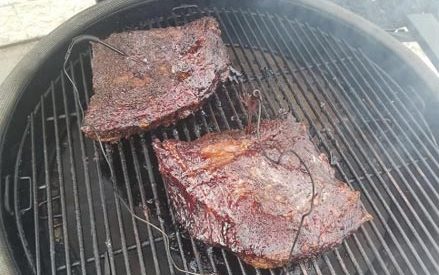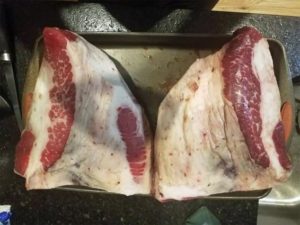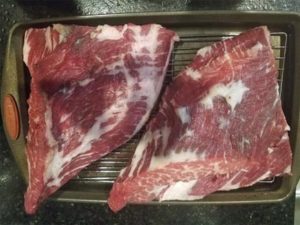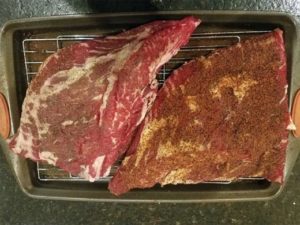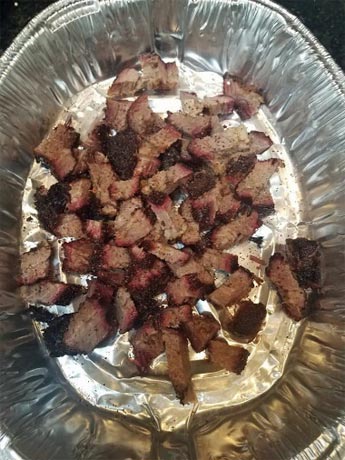Authored by Doug Baker
So you bought one of our unsmoked briskets and want to know to cook it? This post is for you, and while there are many preparations for brisket, this focuses on using it for a Texas style smoked/BBQ cook.
Every cow we butcher has 2 briskets. Each brisket is composed of two muscles. The muscles are commonly known as the point and the flat. A whole brisket will run 13-19ish pounds and since that is a lot of meat we often have our butcher cut them into smaller more manageable portions. The ones we used today were some of our smaller portions rather than a whole brisket (known as a whole packer brisket).
We first let it thaw out so we could trim some of the fat off. There are two muscles in a full brisket, and the grain runs differently but this method can be used on either of them or on a combination as seen in the photos. How much to trim is up to you and how much fat you want in the finished slices or shredded meat. I trimmed this one pretty thin.
Next, it’s time to season it, I generally keep it simple with salt, pepper, seasoning salt and garlic salt but you can get fancy with other rubs or seasonings if you wish. My suggestion is to keep it simple initially and let the flavor of the beef come through and don’t try to overpower it with seasonings.
While I was doing this I was letting my smoker come up to around 250 degrees. There is not a perfect temperature for brisket but any of the normal barbequing temperatures will work. I have had success cooking brisket on a number of different smokers, it does not matter which one you use as long as you understand how to use it. There are as many opinions on what wood to use for smoke as there are people who enjoy BBQ so enjoy finding out what you prefer. If your smoker requires a water pan, you definitely want to use it to keep a moist cooking environment.
I placed the brisket on the smoker and placed a temperature probe in the middle of the meat. I then sit back and relax while it cooks and just monitor the internal temperature. Once the internal temperature reaches 190 degrees I will begin checking it every 3-5 degrees for doneness. My test is that I can take another temperature probe and when I insert it, there is the initial crunch of the bark (or crust) but then it slides in like going through soft butter. At that point or when it reaches 203-205 degrees I remove it. During the cook you will encounter a time when the temperature plateaus or stalls out. This is what is called “the stall” in BBQ parlance and can be annoying. You can at this time wrap your brisket in either butcher paper or aluminum foil and it will not take as long. I don’t often do this step but many famous and competitive chefs do.
Take it in, and you can cover it and let it rest until it cools down to about 140 degrees. This will enable maximum juiciness and tenderness. Then it is time to slice it up and enjoy. As you cut it up you want to cut across the grain for maximum tenderness. You can chop it up for more of a shredded style also. The flat portion of the brisket is better sliced and the point is often better shredded or chopped up.
This is a simpler technique. You can look up other options such as injecting, mopping, turbo briskets, burnt ends, etc. They are different ways to influence the final product but to us a simple one tastes just as good as one that I do all the extra steps for. Left overs are great in chili, soups, tacos, nachos, sandwiches, portioned then frozen and then reheated gently days or weeks later.
I know spending that much money on one cut of meat can be intimidating but hopefully with some knowledge from here you and your family can enjoy it as much as we do.

